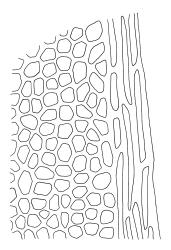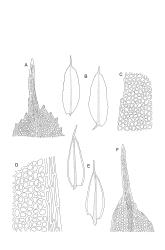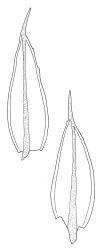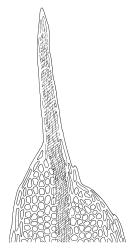- = Rhizogonium aristatum Hampe, Linnaea 40: 314 (1876)
- ≡ Rhizogonium pennatum var. aristatum (Hampe) Dixon, Bull. New Zealand Inst. 3: 220 (1926)
- = Rhizogonium sinuatum Müll.Hal., Hedwigia 36: 333 (1897)
Plants medium-sized, bright green when fresh, turning brown-green in herbarium, forming loose or dense turves. Stems erect, unbranched, pale brown- or yellow-green, c. 15–25(–35) mm, in cross-section with c. 5 layers of thick-walled cells surrounding a large central strand (lacking parenchyma), beset at base with sparse, bright red-brown, smooth rhizoids. Shoots 3–4 mm wide, complanate. Leaves distichous, spreading, asymmetric at base, ovate-lanceolate with an acute apex, neither concave nor decurrent, bordered throughout by 3–5 rows (fewer near apex) of bistratose, elongate cells that are confluent with the excurrent costa, variably serrate in upper half with mostly unicellular teeth, (1.5–)1.9–2.2(–2.5) × 0.3–0.5 mm, becoming smaller and scale-like near stem base. Upper laminal cells firm walled, rounded-hexagonal or ± irregular in shape, mostly c. 15 µm in greater dimension, somewhat longer (to c. 30 µm) and narrower near leaf base; alar cells not differentiated; marginal cells narrow and elongate, mostly 30–90 µm, forming a distinct and bistratose border 3–5 cells wide at mid leaf. Costa c. 60–75 µm wide near base, tapering to c. 40–50 µm at mid leaf, long excurrent to form a stout, smooth or toothed arista c. 220–450 µm long, in cross section (at mid leaf) biconvex, with a central layer of guide cells, and elongate (10–15:1) superficial cells.
Dioicous. Perichaetia at base of stem, with leaves, oblong-lanceolate, costate, not bordered, to c. 2 mm (but apparently lengthening after fertilisation to c. 3 mm). Perigonia brown and budlike, single or in pairs at base of stem, with bracts c. 0.6 mm, ecostate, ovate and acute, concave at base, with filiform, 5-celled paraphyses. Setae c. 25 mm, straight, smooth, twisting weakly to the left below and to the right above (when dry), red-brown; capsules horizontal, oblong-cylindric from a slightly asymmetric base, c. 2.0 mm, smooth and not constricted below the mouth when dry, pale yellow- or red-brown; exothecial cells irregular, mostly oblong-hexagonal or quadrate, 1–3:1, thick-walled, not striate; annulus well differentiated and persistent; operculum rostrate from a conic base, c. 1 mm. Exostome teeth pale yellow-brown, narrowly lanceolate, inserted c. 75 µm beneath the rim, c. 530 µm long, faintly bordered, outer surface finely and densely papillose (non-striolate) below, more coarsely so above, inner surface lamellate; endostome pale, with a high basal membrane; segments nearly as long as the teeth, keeled but not perforate, papillose-baculate; cilia in groups of (2–)3, not nodose, finely baculate. Calyptra not seen. Spores ± spherical, 16–19 µm, pale brown, nearly smooth.
Rhizogonium pennatum could be confused with Calomnion complanatum, with which it often grows on tree fern trunks. Rhizogonium pennatum is a more robust plant with basal rather than the terminal perichaetia seen in C. complanatum. It also lacks the reduced rank of ventral leaves of C. complanatum and has larger leaves (1.5–2.5 mm vs 0.7–1.1 mm long) with a well-developed leaf border, and more stoutly excurrent costae. The peristomate capsules are also very different.
NI: N Auckland, offshore islands only (LB, GB), S Auckland (Coromandel Peninsula, Kaimai Range). SI: Nelson, Westland, Otago (Mt. Cargill), Southland (Fiordland), St; Ch; A; C.
Australasian. Tasmania*, mainland Australia.
Occurring on a variety of shaded substrates including rotten logs, vertical soil banks, tree bases, and tree fern caudices as well as non-calcareous rock such as conglomerates, granite, and mudstone. Well-developed colonies occur on overhanging and strongly weathered granite near the eastern terminus of the Croesus Track in Westland L.D. and on thin humus over shaded quartzite boulder faces at Te Kuha in Nelson L.D. Near the southern limit of its range this species occurs more frequently as an epiphyte on tree ferns. On North I. R. pennatum is known only from a handful of localities with a restricted elevation range of c. 690–950 m; on South I. it occurs mainly in western parts of the island from near sea level (Pororari River, Nelson L.D. and Resolution I., Southland L.D. to at least 960 m (Mt Euclid, Nelson L.D.).
The majority of collections consist of sterile female plants. Perichaetia are generally easily found, while perigonia are very difficult to observe. The rarity of male plants is reflected in a paucity of fruiting collections.
Of the two syntypes designated by Hooker & Wilson, only that collected by Menzies is fertile. The majority of Wilson’s notes (in herb. Wilson) are also based on this collection; it is therefore an appropriate choice as the lectotype. The isolectotype in herb. Hooker (BM K) bears (in Menzies’ script): "No. 90 Dusky Bay N. Zeeland 1791". The lectotype has costae extending 330–380 µm beyond the end of the lamina; the margins are entire except for 1–2 teeth at the base of the arista in approximately half the leaves.
The type material of R. aristatum represents an extreme form of R. pennatum, albeit one not worthy of taxonomic recognition; this conclusion is prevised by comments made by Dixon (1926, p. 220). The leaves are somewhat smaller (c. 1.5 mm) than typical for the species, with some strongly toothed to spinose (with individual teeth to 55 µm). However, the majority of leaves have 4–6 short, rather blunt teeth on one side of the leaf and only sometimes one or two longer, more spinose teeth; there is considerable variability even within single stems. Both in stature and degree of marginal tooth development, the type falls within the range of continuous variation for the species. The occurrence of representative material in Tasmania also argues against recognition of R. aristatum at any taxonomic level.
The Helms collection interpreted here as the type of R. sinuatum is unremarkable in the context of R. pennatum variability. While neither of the two duplicates is labelled as a type, the associated data support this interpretation; it is unlikely that more suitable material can be located in other herbaria.







